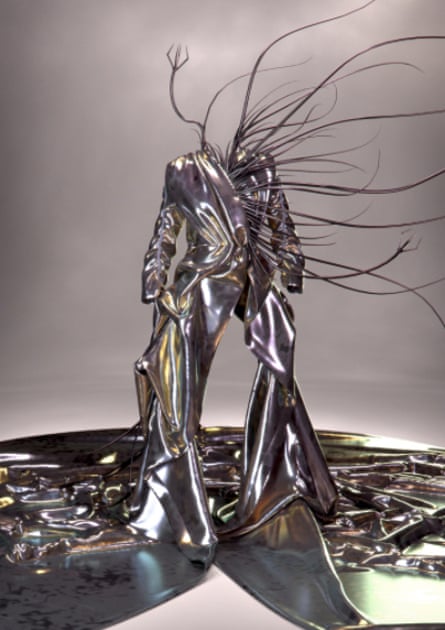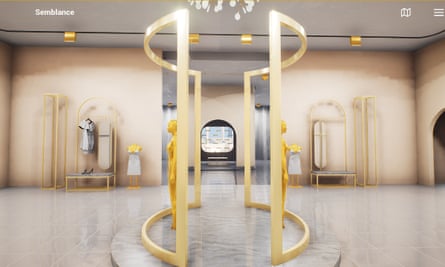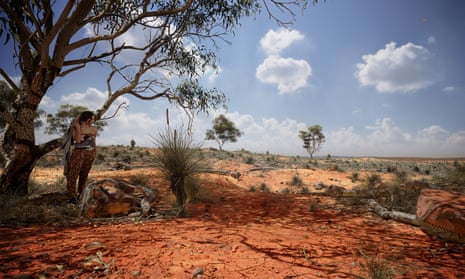In the designer Denni Francisco’s new film, models wearing clothes from her label Ngali wander through a virtual landscape. Using this digital medium, it was possible to take her collection on location, despite being in lockdown and unable to travel.
This was particularly important for Francisco, a Wiradjuri woman, as the landscape used in the film is based on Taungurung Country, in central Victoria, where Francisco was born, and her daughter now lives. She says when she’s designing, connection to Country is at the forefront of her mind. “We’re often talking about how what we do belongs to Country, how it’s connected to Country and how it has a rightful place in Country,” she says.
The VR film will premiere not at a fashion event, but at Melbourne International Games Week. Francisco is one of seven apparel and accessories designers included in a digital fashion incubator project, an initiative of Creative Victoria, that saw independent Victorian designers collaborate with Melbourne-based AR/VR studio Ignition Immersive. Some projects, like Francisco’s, are artistic while others are more pragmatic, allowing would-be customers to virtually try accessories at home using AR filters.

The incubator designers are not the first Australian fashion designers to play with augmented and virtual reality. In June, for Australian Fashion Week in Sydney, Toni Maticevski created a “digital haute couture” overcoat of molten silver that could be “tried on” by fashion week attendees, its tentacled lapel and trailing tails superimposed onto guests, then saved as an image, to be shared on social media.
But these steps, underwritten by Creative Victoria and Australian Fashion Week’s major sponsor Afterpay, respectively, look tentative compared to the efforts of global luxury fashion houses. As it stands now, the metaverse is still an expensive playground, where the world’s biggest, richest brands are fast claiming territory.
In the midst of the pandemic, as stores shuttered and opportunities to dress up evaporated, big brands rushed to extant online worlds like video games, and developed their own VR and AR experiences.
Three enormous luxury conglomerates, Kering, LVMH and Richemont, embraced virtual reality showrooms and trade shows, which often required digital samples of their collections to be developed. Gucci and Dior partnered with Snap, the parent company of Snapchat, to create AR sneaker try-ons.
In September, Balenciaga partnered with Epic Games’ Fortnite so players could purchase outfits, accessories and weaponry. This came after both Burberry and Louis Vuitton introduced their own in-game non-fungible tokens (NFTs) in August. Burberry’s was released for Mythical Games’ Blankos Block Party, while Louis Vuitton created an entire mobile game.

Francisco is optimistic about the power of virtual experiments – and their reach. “So many people will be able to immerse themselves in culture, learn more and understand more using this type of technology.”
Darren Vukasinovic from Ignition Immersive, who collaborated with Franscico on the project, agrees: “VR takes us further with a heightened emotional connection.”
Vukasinovic says there is profit in the future of VR: “We want to see designers monetise and create an economy in that digital world.” He suggests the way to do this is through selling a digital version of a design. “There is a version of you that may want to spend a couple of dollars to wear a Ngali print in your digital avatar world.”
This is already happening through collaborations between the gaming industry and luxury fashion houses, and platforms like DressX, an international retailer that sells virtual clothing that is edited onto an image of the user.
The potential for growth is manifest. The gaming industry has increased by half a billion players in the last three years. Facebook has invested in virtual reality technology and plans to make it widely available, hinting at a future where Zoom meetings are replaced by more immersive 3D experiences in which everyone has their own avatar (and can dress it accordingly).
Li Edelkoort, a trend forecaster who founded the company Trend Union in Paris, says: “I have no doubt it’s going to be an important profit centre. Is it good for society? That is a very different question.”

Edelkoort’s first concern is that the technology isn’t sophisticated enough to capture fashion’s tactility or texture, the things that make fashion “breathtaking”. She also raises the issue of sustainability, and says that while VR and AR might mean consumption of real garments slows if the fantasy moves online, the technology required to make a digital world is also resource intensive.
From digital design to VR runways, augmented reality shopping to stylish avatars, it feels like the metaverse’s only limitation might be how far we can stretch our imaginations.
But like all new technology, access is expensive. Epic Games, the creators of Fortnite, financially supported the creation of Semblance World, a virtual fashion space that is also launching at Melbourne International Games Week, through one of its Epic MegaGrants. Some of Creative Victoria’s digital incubator designers will have their works featured within this platform.
Edelkoort believes the cost will bring independent designers together. She sees a future of “collaborations and co-opting, ateliers and workshops where these things can happen in a collective way”.
This could signal an exciting new frontier of collective creativity for the fashion industry. But promises of freedom, a level playing field and open access were made about cyberspace’s first iterations, too.
ACMI will be hosting a free online panel discussion, Fashion’s New Reality, featuring Denni Francisco and Darren Vukasinovic at 2pm on 8 October.

Comments (…)
Sign in or create your Guardian account to join the discussion